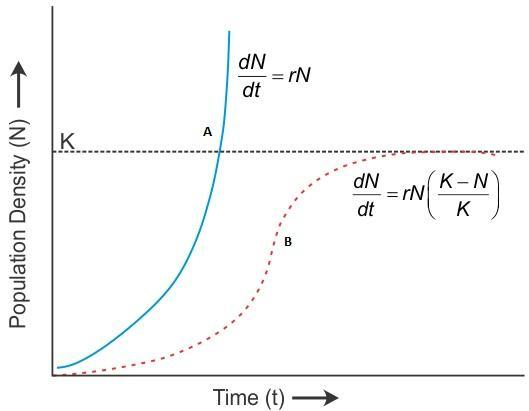
After the exponential increase, population growth declines and stagnates. The growth curve is
A.S-shaped
B.J- shaped
C.Straight line
D.Circular
Answer
481.8k+ views
Hint:In nature, resources are limited. Therefore, the population growth in such habitat initially shows a lag phase, followed by a log and declining phase, reaching the carrying capacity. Such sigmoid shaped curves are called logistic growth curves.
Complete answer:In nature, populations do not have unlimited resources at their disposal. This leads to competition between individuals for limited resources. So, in nature exponential growth usually is not common.
Every natural habitat has fixed resources to support a population of individuals, beyond which no further increase in population can be supported. In a given habitat for that species, this is known as nature’s carrying capacity(K).
A population growing in a habitat with limited resources shows initially a lag phase (when individuals are maturing), and after that log phase when the population is proliferating and increasing in number and decrease (declining phase) and finally the population density reaches the carrying capacity (stationary phase, Asymptote). The graph results in a sigmoid curve. This type of population growth is called Verhulst- Pearl Logistic Growth.

Where,
N = Population density at time t
r = intrinsic rate of natural increase
K = Carrying capacity
In the graph, A curve is the exponential growth curve.
In the graph, the B curve is the logistic curve.
The logistic growth curve is considered a more realistic one.
So, the answer is option A. S-shaped.
Note:When food and space for a population are unlimited, each species reproduces and then the population grows in an exponential ratio as stated by Darwin. When growing in unlimited resources, where there is no competition, the population of such species will reproduce exponentially and reach a large number in a short period. For such a population graph obtained is J- shaped.
Complete answer:In nature, populations do not have unlimited resources at their disposal. This leads to competition between individuals for limited resources. So, in nature exponential growth usually is not common.
Every natural habitat has fixed resources to support a population of individuals, beyond which no further increase in population can be supported. In a given habitat for that species, this is known as nature’s carrying capacity(K).
A population growing in a habitat with limited resources shows initially a lag phase (when individuals are maturing), and after that log phase when the population is proliferating and increasing in number and decrease (declining phase) and finally the population density reaches the carrying capacity (stationary phase, Asymptote). The graph results in a sigmoid curve. This type of population growth is called Verhulst- Pearl Logistic Growth.

Where,
N = Population density at time t
r = intrinsic rate of natural increase
K = Carrying capacity
In the graph, A curve is the exponential growth curve.
In the graph, the B curve is the logistic curve.
The logistic growth curve is considered a more realistic one.
So, the answer is option A. S-shaped.
Note:When food and space for a population are unlimited, each species reproduces and then the population grows in an exponential ratio as stated by Darwin. When growing in unlimited resources, where there is no competition, the population of such species will reproduce exponentially and reach a large number in a short period. For such a population graph obtained is J- shaped.
Latest Vedantu courses for you
Grade 11 Science PCM | CBSE | SCHOOL | English
CBSE (2025-26)
School Full course for CBSE students
₹41,848 per year
EMI starts from ₹3,487.34 per month
Recently Updated Pages
Basicity of sulphurous acid and sulphuric acid are

Master Class 12 Economics: Engaging Questions & Answers for Success

Master Class 12 Maths: Engaging Questions & Answers for Success

Master Class 12 Biology: Engaging Questions & Answers for Success

Master Class 12 Physics: Engaging Questions & Answers for Success

Master Class 4 Maths: Engaging Questions & Answers for Success

Trending doubts
Give 10 examples of unisexual and bisexual flowers

Draw a labelled sketch of the human eye class 12 physics CBSE

a Tabulate the differences in the characteristics of class 12 chemistry CBSE

Differentiate between homogeneous and heterogeneous class 12 chemistry CBSE

Why is the cell called the structural and functional class 12 biology CBSE

Differentiate between insitu conservation and exsitu class 12 biology CBSE




